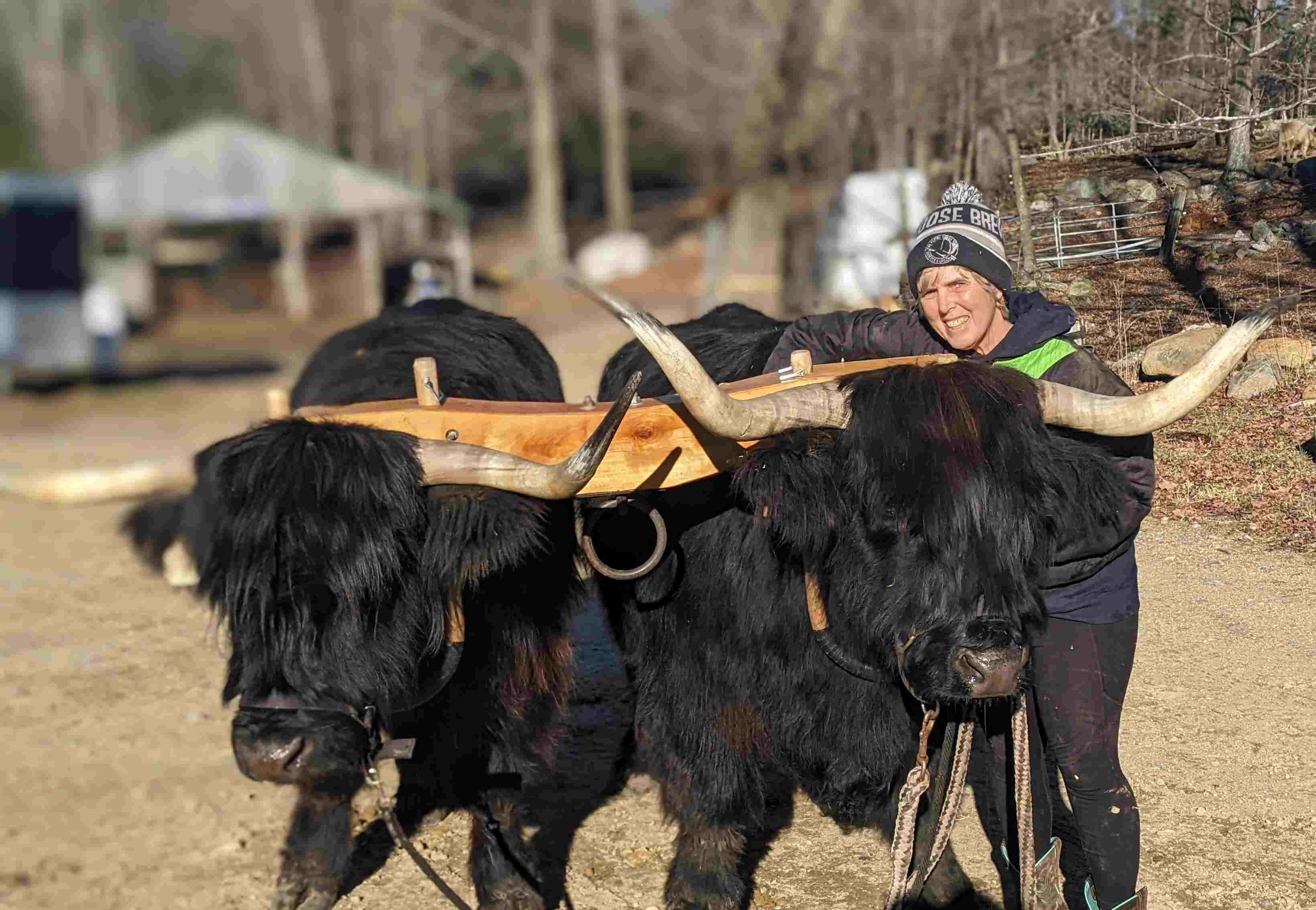Herd Leader
posted on
December 4, 2020

Author Carole Soule with Scottish Highlander team, Topper and Stash, at the Ox Teamster competition in Haverhill, NH in 2017
Have you ever seen a full-sized adult out walking a dog, who runs ahead, pulling its owner along like a water-skier behind a boat? This always looked wrong to me, especially if the dog is a 6-pound Chihuahua. Now, after binge-watching Cesar "The Dog Whisperer" Millan on National Geographic, I know why.
I'll tell you, but since I know more about cattle, I'll start with them. Of the 45 cattle I own, seven of them are my "ambassadors," which I call my working pets. Scottish Highlander Curious Bleu gives cow-back rides. Red, a steer with enormous horns, pulls a cart. Oxen Topper and Stash work as a team in a yoke and follow voice commands, while 8-month-old Joe and Don are learning to do the same. Orphan calf, 6-month-old June, is learning to be a riding cow. It's easy to see a calf's potential, but it takes a leader to make them ambassadors.
What Is An Ambassador Cow?
An ambassador cow or steer won't object to hugs, does not brandish its horns, obeys voice commands, lets children sit on its back -- in short; an ambassador is trusting and submissive. How does a human master an animal without making it anxious?
The first step is to speak "Cow." Replace the word "cow" with any animal – like dog, goat, horse, pig, donkey -- and this system works for any species except maybe felines. Humans are good at communicating with other humans. An angry person scowls. Happy people smile. When sad, we cry. When excited, we talk fast or bubble over a bit. Cows speak a different language that we have to learn.
What Is Important To A Cow?
The most crucial factor in a cow's life is her place in the herd. Put a new cow in with others, and the herd goes wild. Sometimes, depending on the new cow's energy, they chase her around the field. Other times the top cow will head-butt the newcomer until she either gives in or becomes the new leader. Once the hierarchy of the herd is re-established, calm returns.
Chasing and head-butting are cow-language, and so is a cow's energy. To be safe when walking in the herd, I have to establish my position as herd leader. How do I do that? I'm not going to head-butt each cow or chase her, but I can use energy.
Cattle Need A Leader
The cattle need to accept me as leader 100 percent of the time, with no exceptions. Remember that scene with a dog dragging his owner? What would happen if 1,500-pound Topper decided he was the herd leader and not me? Somebody would get hurt, and it probably wouldn't be him.
Topper trusts me as herd leader when I project calm, assertive energy. If I express anger or frustration, he'll stop listening. The good news is that as soon as I calm down, he'll respect me again. It's all about me, not Topper. His behavior and demeanor reflect my energy.
The same is true of that pulling 6-pound Chihuahua. When he drags his owner behind, he has taken the leadership role because his owner has let him. It's easier to see the problem with a huge steer than a tiny dog, but the challenge is the same. The animal, dog, cow, goat, donkey, needs a leader. Is that going to be you?
Next week I'll talk more about how I project energy to keep my status as herd leader.
* * *
And to everyone who came out to feed pumpkins to the cattle, they thank you! If you still have leftover pumpkins (soft or not), apples, turnips, or any other fresh vegetables, bring them out to the farm during store hours (Wednesdays 1-5 p.m., Thursdays-Saturdays 10 a.m.-5 p.m). The cattle are hungry for treats!



